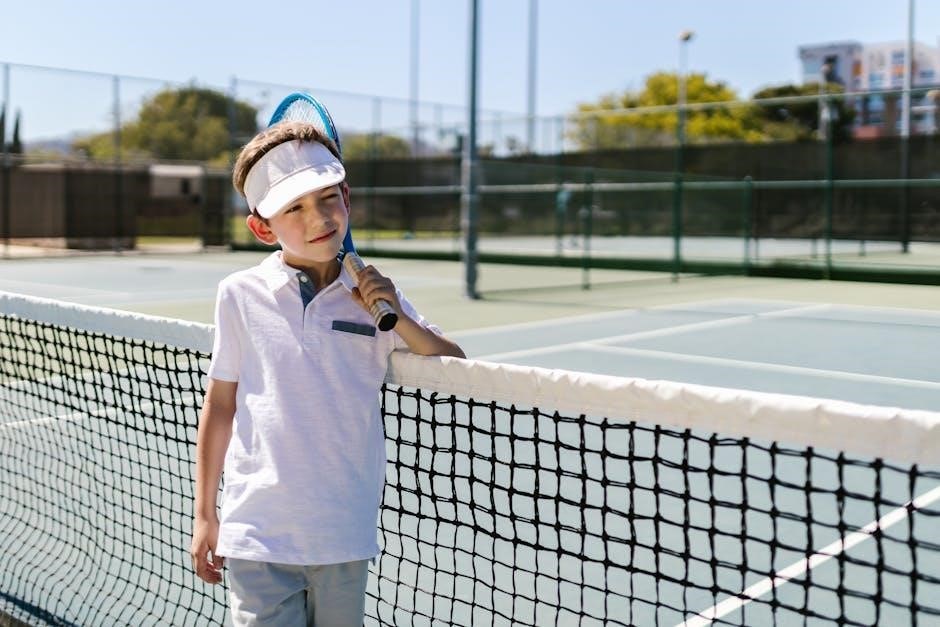Junior tennis racquets range from 17 to 26 inches, with size determined by age and height. Proper fit ensures better technique, control, and reduces injury risk, making it essential for young players’ development.
Importance of Choosing the Right Racquet Size
Choosing the right racquet size is crucial for young players, as it directly impacts their performance and development. A racquet that is too large or too small can make it harder to control, leading to less accurate shots and increased fatigue. Additionally, using an improperly sized racquet can put unnecessary strain on a child’s arm and shoulder, potentially leading to injuries. On the other hand, a well-fitted racquet allows for better technique, more power, and precise shots, fostering confidence and enjoyment of the game. It also promotes proper stroke development, helping young players build a strong foundation for their tennis skills. Selecting the right size ensures a more comfortable and effective playing experience, making it essential for juniors to progress successfully in tennis.

How to Determine the Correct Racquet Size
Determine the correct racquet size by considering the player’s age and height. Use a size chart to match their measurements with the appropriate racquet length, ensuring optimal comfort and performance on the court.
Age as a Guideline
Age is a common starting point for selecting a junior tennis racquet. Children aged 2-4 years typically use a 17-19 inch racquet, while those aged 5-6 years prefer a 21-inch option. For ages 7-8, a 23-inch racquet is ideal, and for 9-10 years, a 25-inch racquet is recommended. These guidelines help match the racquet size to the child’s developmental stage, ensuring they can handle the racquet effectively. However, age alone isn’t always the perfect indicator, as growth rates vary. It’s essential to consider the child’s height and comfort level with the racquet. Using age as a guideline provides a foundation, but personal fit and comfort should also be taken into account to optimize performance and enjoyment of the game.
Height as a Guideline
Height is a key factor in determining the appropriate junior tennis racquet size. Children up to 100cm tall typically use a 17-19 inch racquet, while those between 100-115cm benefit from a 21-inch racquet. For taller players, 115-135cm, a 23-inch racquet is suitable, and for those 135-150cm or taller, a 25-inch racquet is recommended. This method ensures the racquet is proportionate to the child’s body size, allowing for better control and technique. Height guidelines are often more accurate than age because growth rates vary, and some children may be taller or shorter for their age group. By matching the racquet length to the child’s height, young players can maintain proper swing mechanics and generate more power. Always consider the child’s comfort and ability to maneuver the racquet when selecting based on height.

Grip Size for Junior Racquets
Grip size for junior racquets varies, with options typically ranging from 1 to 3. Proper fit is crucial for control and comfort, preventing injuries and enhancing performance. Ensure the grip matches the player’s hand size for optimal playability and technique development;
Grip Size Options
Grip size options for junior racquets are typically categorized as 1, 2, or 3. These sizes correspond to the circumference of the handle, ensuring a comfortable fit for smaller hands. Grip size 1 is the smallest, suitable for very young players or those with petite hands, while size 3 is the largest option for juniors, often used by older or larger children. Proper grip size is essential to prevent discomfort or injury and to allow for proper stroke mechanics. Coaches or parents can measure a child’s hand to determine the best fit, ensuring the racquet feels balanced and easy to maneuver. Many junior racquets come with adjustable grips or replaceable overgrips, allowing for customization as the player grows. Selecting the right grip size supports a young player’s technical development and overall enjoyment of the game.

How to Measure Grip Size
To measure grip size accurately, place the racquet handle in the player’s dominant hand. They should hold it with their index finger and thumb forming a “V” shape at the throat. The middle finger should rest against the handle. The gap between the palm and the handle should be about 1/8 inch for proper fit. If the gap is too large, the grip may be too small, and if it’s too tight, the grip may be too big. Another method is to measure the circumference of the handle using a ruler or grip size gauge. Junior players typically use grip sizes 1, 2, or 3, corresponding to smaller hands. Ensuring the correct grip size prevents discomfort, improves control, and reduces the risk of injury. Parents or coaches can assist younger players in measuring and selecting the appropriate size for optimal performance and comfort on the court.

Additional Factors to Consider
Besides size, consider weight, balance, and string pattern. Lighter racquets aid young players in handling, while balanced racquets enhance maneuverability. Proper string tension supports performance and prevents injury, ensuring a safe and enjoyable experience.
Weight and Balance
Weight and balance are crucial for junior racquets as they impact a child’s ability to maneuver and control the racquet. Lighter racquets, typically between 7 to 9 ounces, are recommended for younger players to prevent fatigue and improve swing mechanics. A well-balanced racquet distributes weight evenly, making it easier to handle. Head-heavy racquets can help generate power, while lighter heads enhance agility. It’s essential to choose a racquet that matches the child’s strength and skill level, ensuring they can maintain proper form and technique. Additionally, a racquet that is too heavy can lead to discomfort and injury, so prioritizing a manageable weight is vital for young players’ development and enjoyment of the game.
String Pattern and Tension
String pattern and tension significantly influence a junior player’s performance. A common string pattern for juniors is 16×19 or 18×20, offering a balance between power and control. Lower string density provides more power, while higher density enhances precision. For younger players, lower string tension (around 50-60 lbs) is recommended to generate additional power and reduce arm strain. As players develop strength and technique, higher tension can improve control. Synthetic strings are durable and easier on the arm, making them ideal for juniors. Natural gut offers better feel but requires more maintenance. Proper string pattern and tension ensure optimal performance and comfort, adapting to the player’s skill level and physical development. This balance supports their progression and enjoyment of the game.
